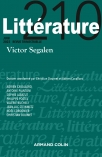
ROMANTISME N°202 (4/2023)
Pour acheter ce numéro, contactez-nous
Recevez les numéros de l'année en cours et accédez à l'intégralité des articles en ligne.
Dans la capitale assiégée par les Prussiens, le bruit des canons n’a pas su recouvrir entièrement les chants parisiens composés pour l’occasion. Les airs et les paroles circulant alors dans les rues ou sur les remparts présentent l’intérêt de donner à lire et à entendre quelques-unes des premières représentations de cet épisode historique, esquissé à chaud. Les formes et thèmes de la chanson populaire, sa liberté de ton ainsi que la variété de ses modes de diffusion amènent des interrogations sur son rôle dans la constitution d’une mémoire collective de l’événement. L’étude attentive d’un corpus de trente-et-une de ces chansons prenant pour objet le déroulement même du Siège permet de contribuer à éclairer les modalités d’inscription de la chanson populaire dans le champ de l’écriture de l’histoire.
In the capital besieged by the Prussians, the noise of the cannon has not been able to completely cover up the songs composed for the occasion. The melodies and words then in circulation in the streets or on the city defence walls present the advantage of giving to read or hear some of the first representations of this historical episode, drawn on the spot. The forms and themes of popular songs, their freedom of expression as well as the variety of their mode of diffusion lead to questioning their role in the constitution of a collective memory of this event. The analysis of a corpus of thirty-one of those songs which took as their theme the development of the Siege enables a better understanding of the way popular song contributes to the writing of history.

